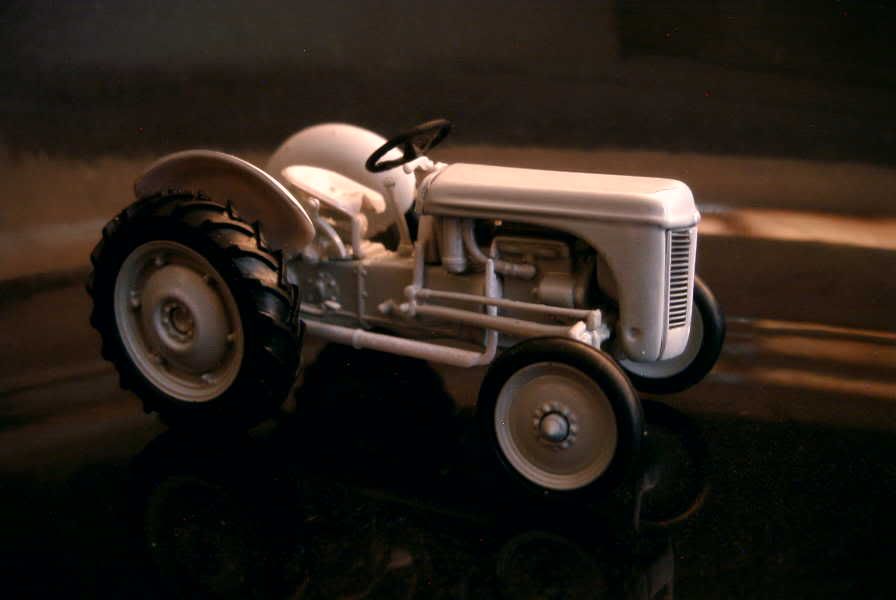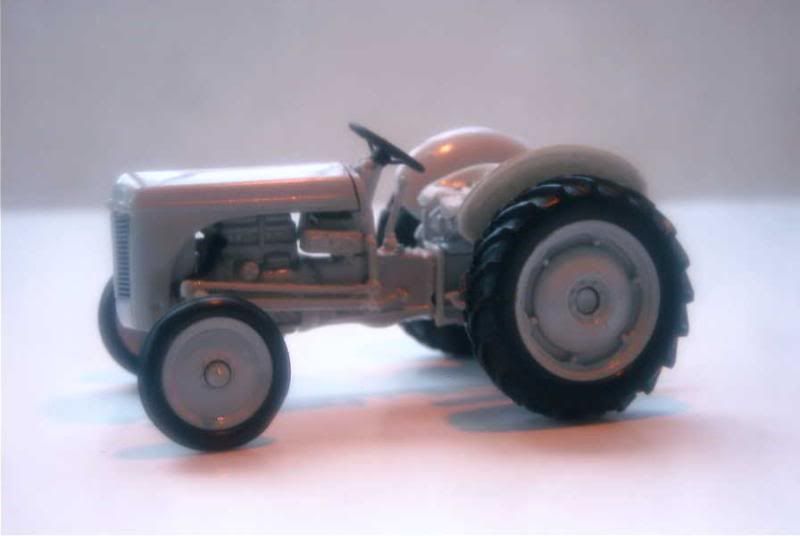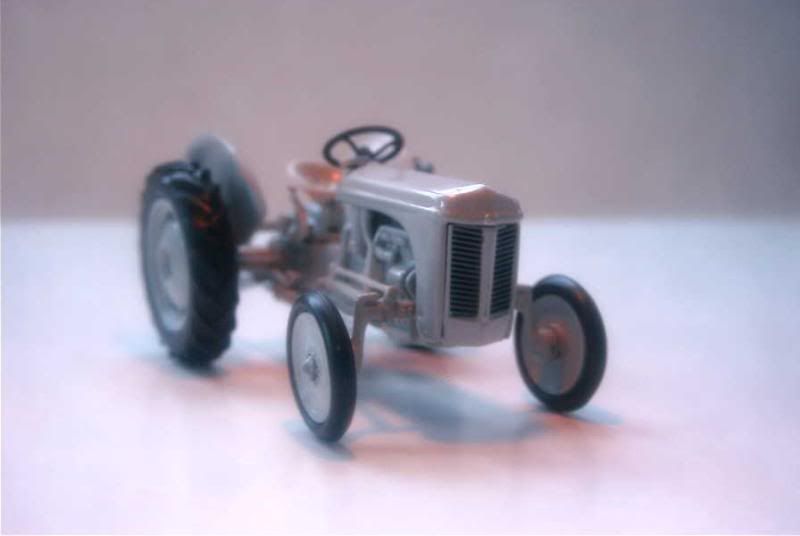A little history
After refining for almost three decades his concept of a tractor’s hydraulic linkage, to which could be firmly fitted a variety of agricultural equipments, British engineer Harry Ferguson was ready to launch full-scale production. Sure enough, he had already seen tractors built under his name by David Brown, but this Ferguson Black had only seen a very limited production run. He had also entered into an agreement with Henry Ford, thanks to which the American company was able to use Ferguson’s patents for its own Fordson tractors. The deal was ended after World War Two by Henry Ford II, grandson to the company’s founder, who nonetheless continued to make use of Harry Ferguson’s inventions – this situation was uneasily settled out of court.
When Harry Ferguson had concluded his 1938 agreement with Henry Ford, he had hoped that Ford’s British subsidiary would have produced his own tractors, but this never materialized. The engineer had to wait a few more years until the end of the conflict brought a solution: many factories which had been in full swing producing armaments were now left without prospects. Ferguson approached Standard and in early fall 1946, the first TE-20 rolled out of the production line at Coventry. Initially powered by a Continental gasoline engine, the standard TE-20 was also produced as the specialized TEB-20 and TEC-20, narrow tractors designed to operate in fields and orchards which configurations would have rendered the TE-20 impractical. Later, the tall TEK-20 would be designed especially for vineyard work. Replacing the American-built Continental, the 1947 TEA-20 would introduce an advanced Standard engine, announcing the blocks used by the postwar automobiles produced by this manufacturer. A diesel engine would also be offered from 1951.
After Harry Ferguson carefully perfected its ideas over the course of many years, the TE-20 was ideally suited for all the tasks intended for it. Better, it is no overstatement to say that it announced all modern tractors. Standard was assembling thousands and thousands of the little grey machines, while a Ferguson factory opened in Detroit as early as in June 1947, and Hotchkiss secured an agreement to produce it in France from 1953. This was that very year when Harry Ferguson sold the whole of his company to the Canadian group Massey-Harris. In the process, the British engineer received shares worth sixteen million dollars from the new Massey-Harris-Ferguson (soon to become the world-famous Massey-Ferguson). He was not a man to retire, though. Through a new company Ferguson Research, he still toyed for a while with the idea of building a tractor but instead went on to design a four-wheel-drive transmission for high-performance automobiles. A Formula One car, the Ferguson P99, was constructed to demonstrate its viability. Despite the fact that this machine had mitigated results on the track, in the end the system equipped the Jensen Interceptor. Harry Ferguson wasn’t around to witness his last success, as he had died at his Gloucestershire home in October 1960. As for the TE-20, its production was stopped in July 1956, after more than half a million were built, many being exported throughout the world. An additional 60,000 had been produced as the Ferguson TO-20 in the United States while 50,000 Ferguson FF-30 were constructed in France by Standard-Hotchkiss until 1957.
About the model
Model: Ferguson TE-20
Year: 1947
Maker: Universal Hobbies
Scale: 1/43
Distributed by: Hachette as no.2 of its Tracteurs et Monde Agricole press series
Acquired: brand new, in June 2006, in Souillac, France
Large amounts of plastic rather than metal have been used to produce this die-cast, which despite this toy-like aspect is a good model: 13/20.



After refining for almost three decades his concept of a tractor’s hydraulic linkage, to which could be firmly fitted a variety of agricultural equipments, British engineer Harry Ferguson was ready to launch full-scale production. Sure enough, he had already seen tractors built under his name by David Brown, but this Ferguson Black had only seen a very limited production run. He had also entered into an agreement with Henry Ford, thanks to which the American company was able to use Ferguson’s patents for its own Fordson tractors. The deal was ended after World War Two by Henry Ford II, grandson to the company’s founder, who nonetheless continued to make use of Harry Ferguson’s inventions – this situation was uneasily settled out of court.
When Harry Ferguson had concluded his 1938 agreement with Henry Ford, he had hoped that Ford’s British subsidiary would have produced his own tractors, but this never materialized. The engineer had to wait a few more years until the end of the conflict brought a solution: many factories which had been in full swing producing armaments were now left without prospects. Ferguson approached Standard and in early fall 1946, the first TE-20 rolled out of the production line at Coventry. Initially powered by a Continental gasoline engine, the standard TE-20 was also produced as the specialized TEB-20 and TEC-20, narrow tractors designed to operate in fields and orchards which configurations would have rendered the TE-20 impractical. Later, the tall TEK-20 would be designed especially for vineyard work. Replacing the American-built Continental, the 1947 TEA-20 would introduce an advanced Standard engine, announcing the blocks used by the postwar automobiles produced by this manufacturer. A diesel engine would also be offered from 1951.
After Harry Ferguson carefully perfected its ideas over the course of many years, the TE-20 was ideally suited for all the tasks intended for it. Better, it is no overstatement to say that it announced all modern tractors. Standard was assembling thousands and thousands of the little grey machines, while a Ferguson factory opened in Detroit as early as in June 1947, and Hotchkiss secured an agreement to produce it in France from 1953. This was that very year when Harry Ferguson sold the whole of his company to the Canadian group Massey-Harris. In the process, the British engineer received shares worth sixteen million dollars from the new Massey-Harris-Ferguson (soon to become the world-famous Massey-Ferguson). He was not a man to retire, though. Through a new company Ferguson Research, he still toyed for a while with the idea of building a tractor but instead went on to design a four-wheel-drive transmission for high-performance automobiles. A Formula One car, the Ferguson P99, was constructed to demonstrate its viability. Despite the fact that this machine had mitigated results on the track, in the end the system equipped the Jensen Interceptor. Harry Ferguson wasn’t around to witness his last success, as he had died at his Gloucestershire home in October 1960. As for the TE-20, its production was stopped in July 1956, after more than half a million were built, many being exported throughout the world. An additional 60,000 had been produced as the Ferguson TO-20 in the United States while 50,000 Ferguson FF-30 were constructed in France by Standard-Hotchkiss until 1957.
About the model
Model: Ferguson TE-20
Year: 1947
Maker: Universal Hobbies
Scale: 1/43
Distributed by: Hachette as no.2 of its Tracteurs et Monde Agricole press series
Acquired: brand new, in June 2006, in Souillac, France
Large amounts of plastic rather than metal have been used to produce this die-cast, which despite this toy-like aspect is a good model: 13/20.






2 comments:
Hi Laurent,
So you appreciate tractors too. They have a very distinct designs on them, thats why they look so attractive. I saw some books on tractors at branches of Booksale. You might wanna visit them.
Best Regards!
Resti
Hello Resti,
Thanks for the information, though I don't have much time to go out right now... When preparing this post I added details to it thanks to The world encyclopedia of tractors and farm machinery by John Carroll, bought years ago in Dymocks (has closed since then), a nice little book about this topic.
Post a Comment